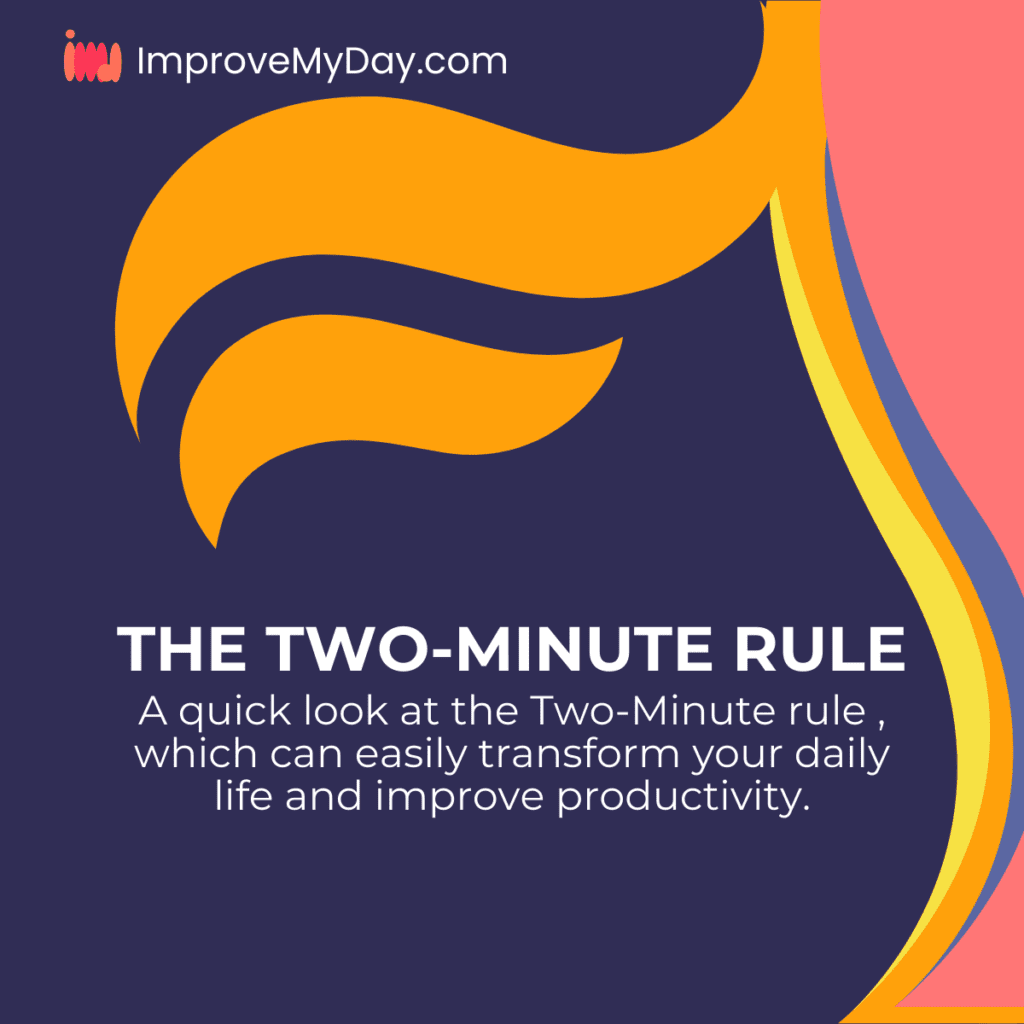Two-Minute Rule – a simple yet powerful technique that can revolutionize the way you approach tasks and boost your overall efficiency. This article will dive deep into the Two-Minute Rule, exploring its origins, benefits, and practical applications to help you supercharge your productivity.
What is the Two-Minute Rule?
The Two-Minute Rule is a productivity hack popularized by David Allen in his book “Getting Things Done.” The concept is beautifully simple: if a task takes less than two minutes to complete, do it immediately. This approach aims to prevent small tasks from piling up and becoming overwhelming, ultimately leading to increased productivity and reduced procrastination.
The Origin of the Two-Minute Rule
David Allen, a productivity consultant and author, introduced the Two-Minute Rule as part of his broader “Getting Things Done” (GTD) methodology. The GTD system focuses on organizing tasks and managing workflow to increase productivity and reduce stress. The Two-Minute Rule serves as a quick decision-making tool within this larger framework, helping individuals tackle small tasks efficiently.
The Science Behind the Two-Minute Rule
The effectiveness of the Two-Minute Rule is rooted in psychological principles that influence our behavior and decision-making processes.
Overcoming Procrastination
According to research published in the Journal of Personality and Social Psychology, people often procrastinate due to a phenomenon called “time inconsistency.” This refers to the tendency to value immediate rewards more highly than future ones. The Two-Minute Rule capitalizes on this by providing an immediate sense of accomplishment, making it easier to overcome the urge to procrastinate.
Building Momentum
The Two-Minute Rule also taps into the psychological concept of “momentum.” By completing small tasks quickly, you create a sense of progress that can motivate you to tackle larger tasks. This momentum can lead to increased productivity throughout the day.
Implementing the Two-Minute Rule in Your Life
Now that we understand the principles behind the Two-Minute Rule, let’s explore how to put it into practice:
- Identify Two-Minute Tasks: Start by recognizing tasks that can be completed in two minutes or less. These might include responding to a quick email, filing a document, or making a short phone call.
- Act Immediately: When you encounter a two-minute task, don’t delay – do it right away. This immediate action prevents the task from lingering on your to-do list.
- Be Realistic: Not every task can be completed in two minutes. Be honest with yourself about the time required for each task.
- Use a Timer: If you’re unsure about the duration of a task, use a timer. This helps you stay accountable and prevents two-minute tasks from stretching into longer time commitments.
- Integrate with Your Workflow: Incorporate the Two-Minute Rule into your existing productivity system. Whether you use a digital task manager or a physical planner, make the rule a part of your regular routine.
Benefits of the Two-Minute Rule
Implementing the Two-Minute Rule can lead to several productivity benefits:
1. Reduced Mental Clutter
By tackling small tasks immediately, you free up mental space that would otherwise be occupied by a growing list of minor to-dos. This mental clarity can help you focus on more significant projects.
2. Increased Efficiency
The Two-Minute Rule helps you make the most of small pockets of time throughout your day. Instead of waiting for a large block of time to tackle your to-do list, you can chip away at it consistently.
3. Improved Time Management
By quickly addressing small tasks, you prevent them from accumulating and becoming time-consuming backlogs. This proactive approach can significantly improve your overall time management.
4. Enhanced Motivation
Completing tasks, even small ones, triggers the release of dopamine in the brain. This “feel-good” neurotransmitter can boost your motivation and encourage you to tackle larger tasks.
Overcoming Challenges
While the Two-Minute Rule is straightforward, you may encounter some challenges when implementing it:
Interrupting Deep Work
Be cautious about letting two-minute tasks interrupt periods of deep focus. If you’re in the middle of an important project, it might be better to defer small tasks until you reach a natural break point.
Underestimating Task Duration
Some tasks may seem like they’ll take two minutes but end up requiring more time. Be prepared to reassess and reschedule if a task turns out to be more complex than initially thought.
Overusing the Rule
Not every small task needs to be done immediately. Use discretion and prioritize tasks based on their importance and urgency, not just their duration.
Combining with Other Productivity Techniques
The Two-Minute Rule can be even more powerful when combined with other productivity strategies:
- Pomodoro Technique: Use the Two-Minute Rule during your short breaks between Pomodoro sessions to knock out quick tasks.
- Eisenhower Matrix: Prioritize your two-minute tasks within the context of the Eisenhower Matrix to ensure you’re focusing on what’s truly important.
- Time Blocking: Allocate specific time blocks in your schedule for addressing two-minute tasks, preventing them from disrupting your main work periods.
Conclusion
The Two-Minute Rule is a simple yet effective productivity hack that can significantly impact your daily efficiency. By tackling small tasks immediately, you can reduce mental clutter, improve time management, and build momentum for larger projects. While it’s not a one-size-fits-all solution, incorporating the Two-Minute Rule into your productivity toolkit can help you make steady progress towards your goals.
Remember, productivity is about more than just getting things done quickly – it’s about making meaningful progress on what matters most. Use the Two-Minute Rule as part of a balanced approach to time management, and you’ll be well on your way to boosting your productivity and achieving your objectives.



